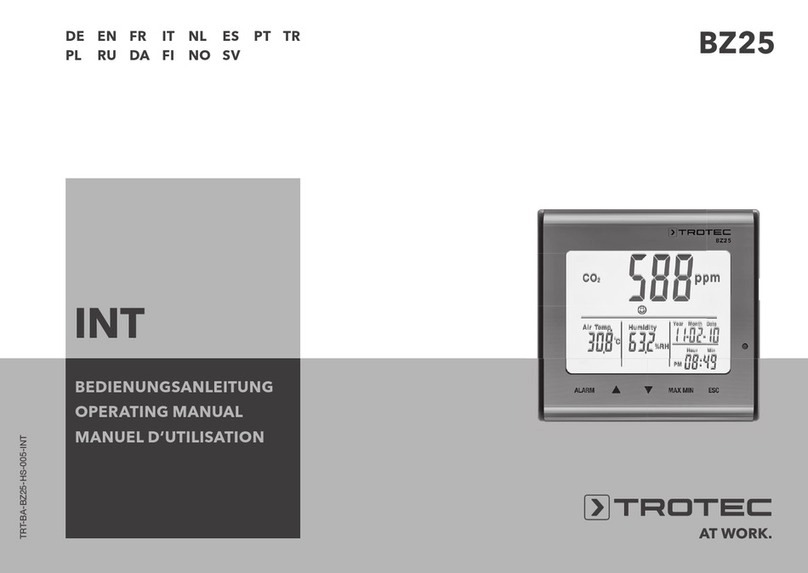
10 EN
thermohygrometer BZ290S
Operation
Before positioning the device, observe the following:
• Do not expose to direct sunlight.
• Do not position directly above a heater.
• If possible, position at an interior wall; avoid cooler exterior
walls.
When positioning the outdoor sensor, observe the following:
• Do not expose to direct sunlight.
• Set up protected from direct rain.
• Do not place near door and window openings.
• Do not position horizontally.
Tips and notes on the humidity level in living spaces
General information:
Medical studies of recent years have demonstrated that an
increased indoor humidity level of well above 50 to 60% RH
promotes asthma and allergies. A low relative humidity of 30 to
40%, on the other hand, is harmless. Occasionally, the relative
humidity level in flats with a good air exchange can even drop
below 30% during harsh winters without being detrimental to
human health.
For the most part, it is the residents themselves who determine
the humidity level in their living spaces during the heating
period from October to April. A household of 3 to 4 persons
emits about ten litres of water vapour into the room air every
day, inter alia by taking showers, washing, cooking and
breathing. As modern window seals are very tight to save
energy costs and provide noise protection, this large amount of
humidity must be released to the outside by airing several times
a day.
The type of heating and ventilation determines the average
relative humidity level in a flat during the winter. Since cold air
always has a lower absolute moisture content than normal room
air, the humid air can easily be exchanged by fresh, dry air in
the winter by repeated brief and intensive airing throughout the
day. Every living space that is not equipped with a ventilation
system requires air changes several times a day, depending on
the occupancy and moisture emission.
A limitation of the relative humidity to prevent too high humidity
levels is only required during the heating period starting in
autumn. It is recommended to maintain a temperature of
approx. 20°C in the entire flat.
In winter:
In case of average outside temperatures below approx.+5°C,
sufficient air changes and a room temperature of approx.20°C,
a relative humidity level between 40 and 50% can easily be
obtained. If it exceeds 50%, the room should be ventilated.
During frost periods, an indoor humidity level of less than
40%RH is perfectly normal. The upper limit of 40 to
50%RH(at approx. 20°C) needs to be observed particularly in
old buildings with little thermal insulation, as exceeding this
value for a prolonged time increases the risk of mould
formation.
In autumn or spring:
At milder outside temperatures between 5 and 15°C on
average, the humidity level may reach 50 to 60%RH.
Please note:
Relatively speaking, warmer rooms are drier and colder rooms
get more humid. This is why it is recommended to maintain a
room temperature of at least 16°C.
Correct airing:
If your window panes mist up frequently or mould starts to grow
on walls, it is high time to review and, if necessary, break your
old habits. The answers to the following questions can be
useful:
Please note that the hygrometer must not be exposed to hot
water or water vapour, otherwise the measurement accuracy
can no longer be guaranteed.




























